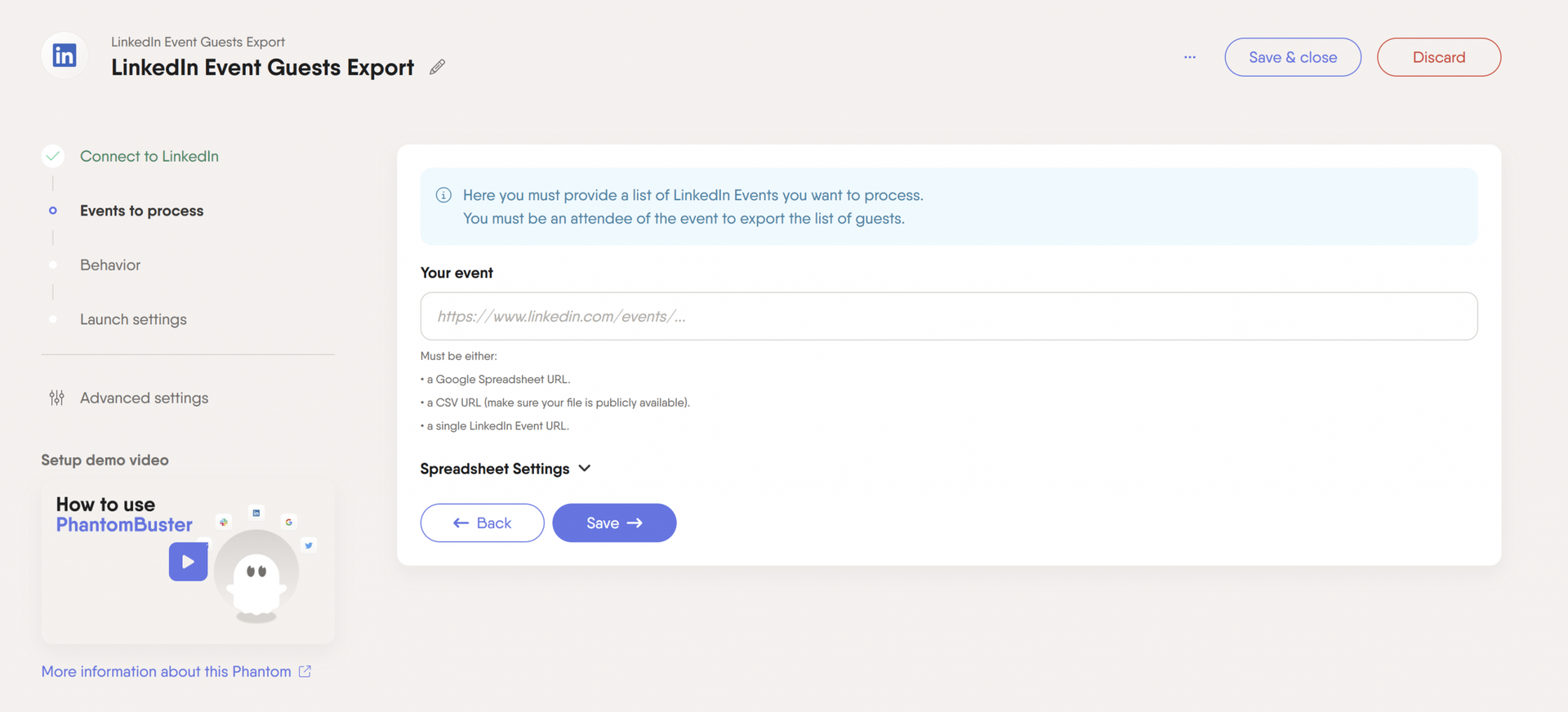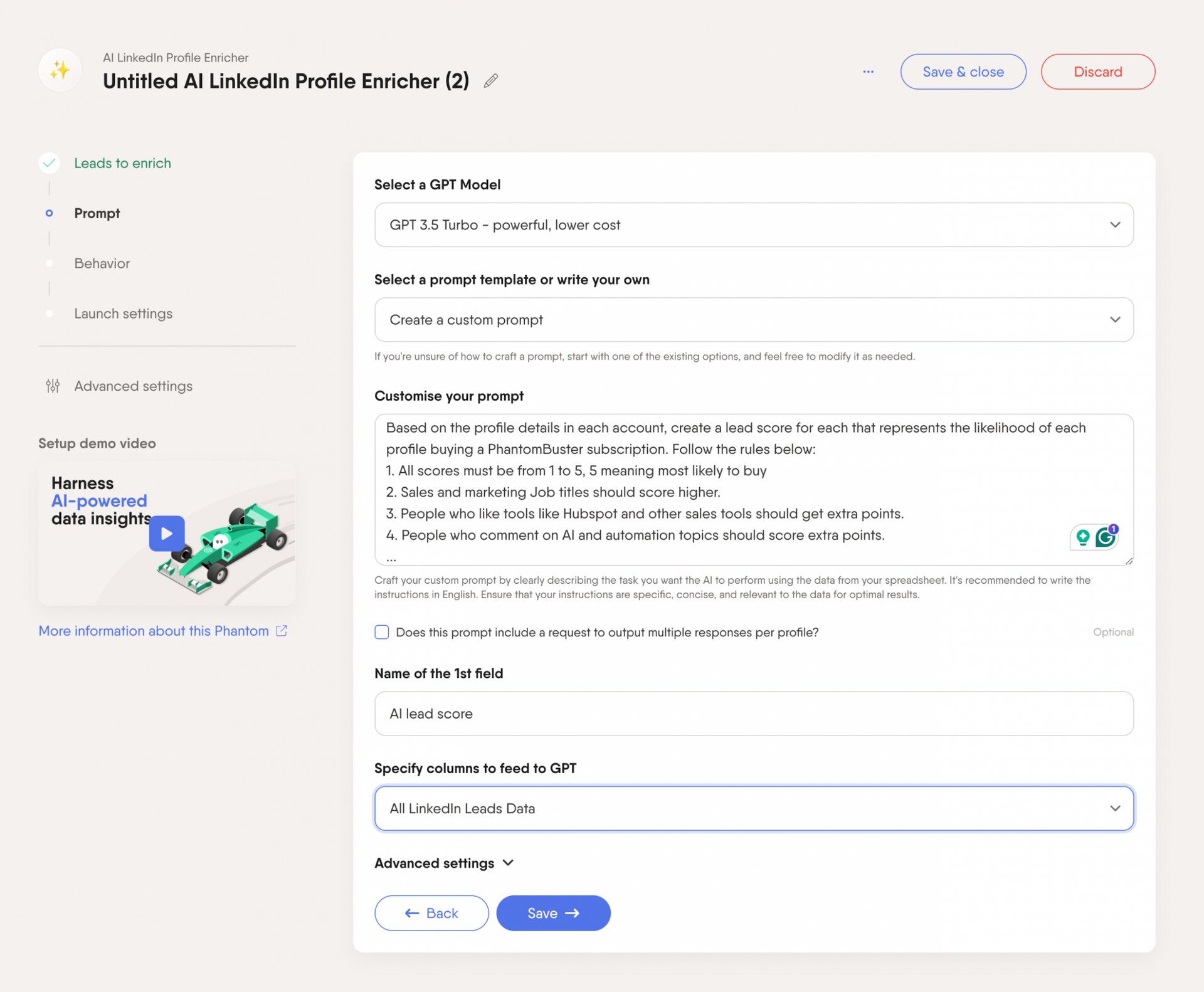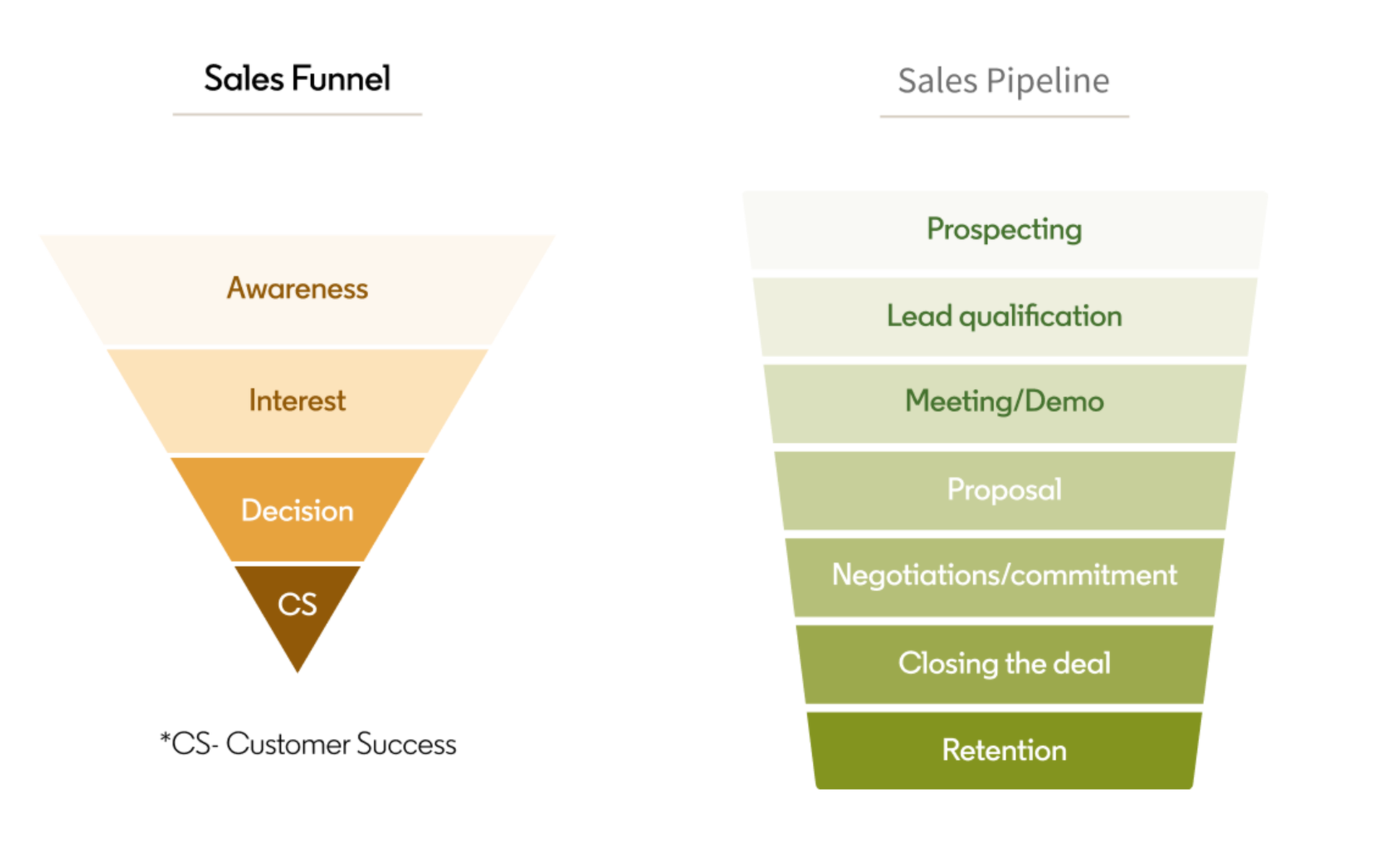Sales pipeline vs. sales funnel—is there even a difference? If so, what should your sales team use to drive more revenue?
A sales pipeline outlines various steps sales reps must take to close deals. It involves stages like lead generation, qualification, and outreach. On the other hand, a sales funnel looks at the stages a buyer goes through before making a purchase.
Let’s take a look at their differences in detail.
AI highlights
- A sales pipeline outlines the sales team’s actions to move deals forward, from finding to qualifying leads to reaching out to them.
- A sales funnel maps out the stages of the buyer’s journey and connects them to the sales process.
- Key differences between a sales funnel and a sales pipeline include:
| Sales Pipeline | Sales Funnel | |
| Definition | Visual representation of sales reps’ steps to engage and convert leads. | Visual representation of prospects’ interactions with your brand, from initial contact to closing. |
| Purpose | Streamlining sales workflows and improving lead management. | Understanding prospects’ needs, pain points, and expectations across their journey. |
| Focus | Sales team’s perspective of the sales process. | Buyer’s point of view of the sales process. |
| Stages | Lead generation and prospecting, lead qualification, meeting, proposal, closing, and retention. | Awareness, interest, decision, action. |
| Key Metrics | Average deal size, customer lifetime value, sales velocity. | Drop-off rates, conversion rates. |
| Actionability | Provides actionable insights to move deals forward. | Provides insights into what buyers need and why leads drop off. |
| Best Tools | PhantomBuster, LinkedIn Sales Navigator, AiSDR, HubSpot | CRM platforms, behavioral analytics tools. |
What is a sales pipeline?
A sales pipeline is a visual representation of the steps sales professionals must follow to close deals. Think of it as a roadmap that outlines what sales reps should do to find, qualify, nurture, and convert leads.
With a well-defined sales pipeline, you can clearly see where each prospect is in the purchase journey.
Also, it lays out a framework for what you must do at different stages, such as lead prospecting, qualification, and outreach.
Why is the sales pipeline important?
Think of a sales pipeline as the guiding light for your sales process. Without it, you are left with a disorganized frenzy of potential customers and missed opportunities. Its key benefits include:
- Effective pipeline management: Sales reps can tailor their efforts based on a prospect’s position in the sales pipeline, improving conversion rates and sales cycle lengths.
- Improved resource allocation: Sales managers can identify high-priority leads and allocate resources better to maximize revenue.
- Accurate revenue forecasting: With a clear glimpse of prospects in various stages, sales teams can easily draw up revenue projections.
- Increased sales productivity: Instead of wasting time on low-value sales activities, reps can build relationships and close deals faster.
- Enhanced customer experience: When sales reps engage prospects with personalized communication at the right time, it creates a smooth buying journey and boosts the customer experience.

Sales pipeline stages
The structure of a sales pipeline depends on factors like the complexity of your buying process and your target audience.
However, a standard sales pipeline covers lead generation and prospecting, lead qualification, sales meeting, proposal/negotiation, closing, and retention. Sales leaders must adapt these stages to their teams’ specific needs.

Let’s take a closer look at these stages now.
Lead generation and prospecting
The first step is to find prospects who might be interested in your product/service.
Here are a few tips to identify the right prospects:
- Watch your competitors: Monitor engagement on a competitor’s top-performing social media posts to identify people interested in your offerings. We recommend using PhantomBuster’s LinkedIn Post Commenter and Liker Scraper to extract those leads automatically.
- Leverage LinkedIn events: Connect with attendees of LinkedIn events like webinars, virtual conferences, and live Q&A sessions. PhantomBuster’s LinkedIn Event Guests Export can help you here.

- Create gated content: Publish well-researched industry reports, surveys, and whitepapers. Let people access these resources for free in exchange for their email addresses with an effective landing page.
Lead qualification
Each lead is different. While some leads might be ready for purchase soon, others may have needs your product/service won’t fulfill. Pursuing these leads can be a waste of your team’s resources.
That’s where lead qualification steps into the picture.
Here’s how it works:
- Define your ICP: Outline the needs, pain points, interests, goals, and other attributes of your ideal buyer.
- Enrich your leads with key details: Use lead enrichment tools, such as PhantomBuster’s LinkedIn Profile Scraper, to learn more about their job, company, needs, and preferences.
- Score your leads: Assign points to each prospect based on their demographics, firmographics, and engagement with your brand.
💡 To seamlessly score your leads using AI, try PhantomBuster’s AI LinkedIn Profile Enricher and customize a prompt to calculate a score based on your criteria. The AI will use available data that was previously scraped to analyze each contact on your list.

Sales meeting or demo
Now that a lead has shown buying signals, it’s time to showcase your offerings to them.
Depending on the nature of your product/service and the complexity of the buying process, you can choose between in-person and virtual meetings.
Here are a few tips for effective sales meetings:
- Research your prospect: Look beyond needs and expectations and learn about their organization’s decision-making process and hierarchy. Try gathering as much information as possible.
- Build a personal connection: Make a strong first impression by congratulating them on a recent achievement or discussing a topic of common interest. The idea is to build a rapport with them.
- Tailor your pitch: Make the most of your time with the lead by highlighting how your solution addresses their goals and pain points. Use client testimonials and case studies to make your pitch more compelling.
Sales proposal
After a successful meeting and product demo, it’s time to make your offer. Typically, a sales proposal outlines your solution and its benefits, pricing, payment terms, and implementation timeline.
Include social proof to demonstrate how your solution helped other real-life buyers. Also, use a clear call-to-action to outline a lead’s next steps, such as signing a contract or making a payment.
Closing
It’s what you’ve been waiting for all along. This is where your sales team’s efforts and negotiations culminate.
The prospect is ready to make a purchase, and it’s up to you to iron out the final details, like delivery dates and onboarding plans.
Retaining
Your sales team passes the baton to customer success. It’s their responsibility to delight new customers with a hassle-free onboarding experience and proactive support.
They also identify suitable cross-sell and upsell opportunities to generate more revenue.
What is a sales funnel?
A sales funnel represents the stages a prospect goes through before converting into a paying customer. It tracks the buyer’s journey from their first contact with your brand to the purchase.
It’s called a funnel as it’s the widest at the top (Awareness stage) and keeps narrowing with each subsequent stage. That’s because fewer leads have a buying intent and move toward conversion.
Why is the sales funnel important?
A sales funnel examines the sales process from the buyer’s perspective. It also measures the number of leads moving from one stage to the next and helps identify friction points.
Implementing one offers the following benefits:
- Improved personalization: Understanding where a lead is in the buyer’s journey helps sales and marketing teams align their efforts to help leads achieve their goals for that particular stage.
- Increased conversions: Sales managers can track conversion rates at each sales funnel stage and identify drop-off points. It helps pinpoint and eliminate bottlenecks in the sales process.
- Better lead management: With a clear overview of where each lead stands in the buyer’s journey, sales reps are better equipped to engage and nurture them.
- Improved customer experience: Relevant and personalized content and engagement create a seamless experience for prospects at each stage.

Sales funnel stages
A sales funnel typically contains three broad segments:
- Top-of-the-funnel (TOFU): Prospects are introduced to your brand for the first time.
- Middle-of-the-funnel (MOFU): They become leads, learn more about your solution and evaluate other options.
- Bottom-of-the-funnel (BOFU): Leads have come to a decision but need a final push to buy from you.
Each segment can be further broken down into different stages, such as awareness, interest, decision, and action. Let’s discuss these stages in detail.

Awareness
This is where a prospect discovers your brand. They start understanding their problems but aren’t looking for solutions yet.
Your goal, at this stage, isn’t to promote your offerings. Instead, you should focus on building brand awareness and a prospect list.
Engaging content, such as blogs, social media posts, podcasts, and videos, can help grab a prospect’s attention.
💡Tip: Use a tool like PhantomBuster’s LinkedIn Post Commenter and Liker Scraper to start building your prospect list of people interacting with your content or even competitors’ or industry influencers’ posts.
Interest
At this stage, the prospect better understands their problems and shows interest in your brand and offerings. They start considering various solutions to their issues.
Gated content, such as case studies, e-books, and whitepapers, is handy here. Prospects will happily share their contact information in exchange for these resources. The idea is to educate leads about your solution and its value without being overly pushy.
Decision
With effective nurturing, leads have reached a stage where they’re ready to purchase. However, they might still be weighing a few options and need your slight push to decide.
Engage in one-to-one consultations to clarify last-minute doubts. Use time-sensitive promotions and money-back guarantees to help them reach a decision faster. Furnish social proof, such as testimonials and industry endorsements, to win their trust.
Action
The lead is convinced that your products/services are the best fit for their needs.
Your goal here should be to create a smooth purchase process. If they’re buying online, design a hassle-free checkout experience. For offline purchases, outline buyer-friendly payment terms and delivery timelines.
Sales pipeline vs. sales funnel: Key differences
Both the sales pipeline and the sales funnel help improve lead management and conversion rates.
But, they look at the sales process from different points of view. Let’s take a closer look:

- Focus: A sales pipeline outlines the steps sales teams should take to close deals. However, a sales funnel focuses on the leads and defines the stages they go through during the purchase journey.
- Purpose: While a sales pipeline helps streamline sales team workflows and improves productivity, a sales funnel helps deliver personalized content and guidance.
- Stages: A sales pipeline involves steps like lead generation and prospecting, qualification, meeting, proposal, closing, and retention. A sales funnel, on the other hand, includes stages like awareness, interest, decision, and action.
- Key metrics: Sales pipeline metrics include average deal size, customer lifetime value (CLV), and sales velocity. Sales funnel metrics focus on drop-off rates and conversion rates at each stage.
To sum it up, a sales pipeline is a tool for sales teams to track and manage deals, while a sales funnel is a model for businesses to understand and optimize the customer journey.
Can sales reps use a sales pipeline and sales funnel together?
The short answer is yes; both help you boost your sales efforts.
A sales pipeline and a sales funnel don’t exist in isolation. Both are interdependent and help optimize your sales strategy.
Sales funnels offer a closer glimpse of target customers’ needs and pain points at different stages. That, in turn, allows sales teams to design a more effective and healthy sales pipeline.
With a well-structured pipeline, more leads progress across the funnel, ultimately improving conversion rates.
The question isn’t whether you should use one or the other. Instead, sales teams must combine both a sales pipeline and a sales funnel to gain deeper insights into prospects, improve lead management, and close deals faster.
